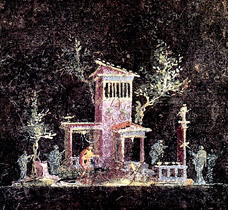 1>
1>Numerous vignettes found throughout Pompeii and Herculaneum depict sanctuaries in which offerings are being made to the gods and ancestors. The narrative action depicted in these paintings underpins Roman wall-painting as a gateway to metaphysical worlds. Although the vignettes are often small inserts in larger compositions, they are nevertheless highly informative in terms of the sacrificial act, sanctuary architecture and their symbolic interaction with nature (fig.1). [Knauer 1990:16 refers to this image as a sanctuary containing an Egyptian wind cooling tower and that both ..."evoke a heightened existence and feelings of supreme well-being and happiness.”]
It is also clear from the numerous vignettes depicting sacrificial acts that votive offering took many forms, such as the giving of cakes, wine, incense, fish, fowl and game (fig.2). A fragment of a wall-painting now in the Museo Archeologico Nazionale di Napoli depicts a sacrificial act in which a woman is placing a pear at the base of a tholos. The pear, possibly emblematic of either Hera (Juno), Aphrodite (Venus) or Pomona, a purely Italian goddess of gardens and harvests, is strangely large in comparison with the woman. In an almost child-like way the oversised pear emphasises the votive ritual and hierarchy associated with sacrifice. The fish and fowl on either side echo the culinary theme, whilst also pointing to realms that are above and below that which is human. Demonic masks either side of the aediculae opening add yet another layer associated with apotropaic guardianship (fig.3-4).
|